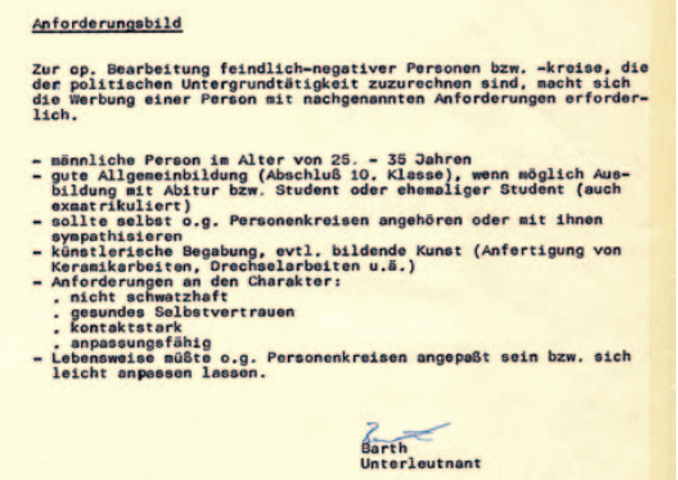Performance Art & Secret Services | State (Re)-Actions
This research area is focused on state performances that document, prohibit, or radicalize artistic performances. On the one hand we deal with secret services’ methods of documentation in various Eastern European countries, on the other hand we investigate counteractions and performative censorship devices.
This research will be published in monographs by Sylvia Sasse and Kata Krasznahorkai and in the research exhibition “Artists and Agents. Performance Art and the Secret Services” curated by Sylvia Sasse, Inke Arns and Kata Krasznahorkai a the HMKV Dortmund in Fall 2019, accompanied by a publication.

State secret-police organizations provided for less voluntary archivisation and documentation. The opening of various secret-police archives has made the documentation of performances carried out by government bodies accessible and researchable, above and beyond artistic self-documentation and performance theory. The analysis of the files shows both the fascination with and fear of performance art on the part of the state. By means of this the state initiated its own performance theory that can be traced in the files of the secret services. To identify what performance and happenings were per se, was crucial for the orientation of the official state doctrine concerning visual art in general. Approached critically, these files not only offer information about the strategies chosen by artists but also about the efforts the secret services have been undertaking in order to eliminate or integrate this specifically Eastern European way performance art was understood into their strategy of operation. The documents’ high level of misinformation, imprecision or intentional misinterpretation complicates their use as reliable sources.

Furthermore, this research area will involve the state practices employed to prohibit, interrupt or radicalize artistic activity. Instead of the traditional censorship method – the prohibiting of artistic work – the state arranged counter-actions or enforced bans through indirect means. We call this practice “performative censorship”. The most famous example is the so-called Moscow Bulldozer Exhibition of 1974: an open field selected by the artists as an exhibition space was already occupied, at the very moment in which the artists arrived on the scene with their pictures, by workers hired by the KGB to create a park. The exhibition action was thus not averted but rather brought to a halt by a counter-action.
As part of this research area, a monograph will focus on the interaction between artistic and state actions in Hungary (Kata Krasznahorkai) and an exhibition module will compare various documentation practices, counteractions and the performative censorship carried out by the state in Eastern European countries (Kata Krasznahorkai, Sylvia Sasse).
Publications to date
Kata Krasznahorkai: Surveilling the Public Sphere. The First Hungarian Happening in Secret Agents Reports, in: Performance Art in the Second Public Sphere: Event-based Art in Late Socialist Europe (Routledge Advances in Theatre & Performance Studies) Routledge, New York, 2018. P. 127-138.
Kata Krasznahorkai: Black or White? Angela Davis, Bobby Seale und Black Power zwischen Staatssicherheit und Happenings im Ungarn der 1970er Jahrein Ungarn, in: Forum Modernes Theater (forthcoming).
Kata Krasznahorkai: “Das Happening vor Gericht”, in: Sandra Frimmel, Mara Traumane (ed): Kunst und Literatur vor Gericht, (forthcoming).
Kata Krasznahorkai: “Heightened Alert: The Underground Art Scene in the Sights of the Secret Police—Surveillance Files as a Resource for Research into Artists’ Activities in the Underground of the 1960s and 1970s” , in: Bazin, Jérôme, Pascal Dubourg Glatigny, and Piotr Piotrowski (ed), Art beyond borders: artistic exchange in communist Europe (1945-1989), Central European University Press, 2015. P. 125-139.
Sylvia Sasse: “Performative Zensur,“ Vortrag auf der Konferenz: Unfreiwillige Spiele, FU Berlin, 3.-4-.7. 2015.
Kata Krasznahorkai: Geheimdienst und Underground. Wie Spitzel unser Wissen über Kunst vermehren, Frankfurter Allgemeine Zeitung, 07.1. 2012, „Bilder und Zeiten“, Z3.
Sylvia Sasse: “KGB: The Art of Performance. Action Art or Actions against Art?” Artmargins, http://www.gss.ucsb.edu/artmargins/ 1999.
Photo credits
BSTU: “Eingeschränkte Freiheit.“ Der Fall Gabriele Stötzer, Berlin 2014, 45, 54, 62.
Buldozernaya vystavka (Bulldozer Exhibition), 1974, http://www.istpravda.ru/artifacts/10736/.

You must be logged in to post a comment.